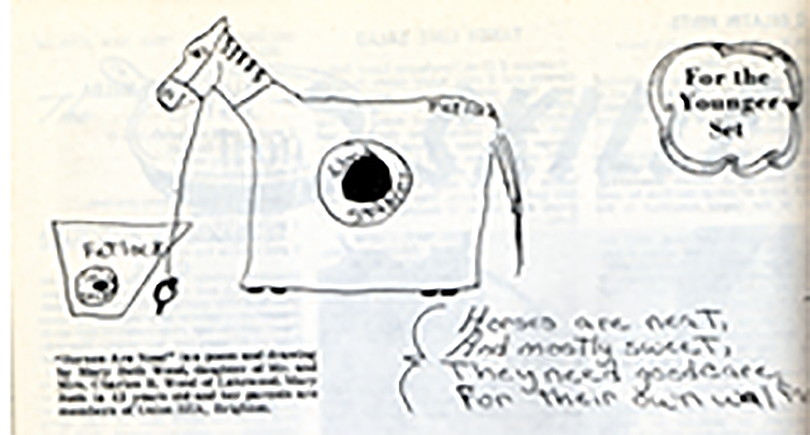By Kristen Hannum:
It doesn’t always sound as though Mona Neeley and Donna Wallin are talking about a magazine when they describe Colorado Country Life.
“It’s family,” says Neeley, the magazine’s editor and publisher.
“And we all need family,” associate editor Wallin explains.
 Magazine, family or some combination of the two, Colorado Country Life turns 60 years old with this October 2012 issue. It’s gone through dozens of changes over those years — from a newspaper tabloid to a magazine format, from spreading the word about how great washing machines are to articles explaining R-values, from Truman to Obama. It’s also seen more than half a dozen editors and gone by nearly as many names.
Magazine, family or some combination of the two, Colorado Country Life turns 60 years old with this October 2012 issue. It’s gone through dozens of changes over those years — from a newspaper tabloid to a magazine format, from spreading the word about how great washing machines are to articles explaining R-values, from Truman to Obama. It’s also seen more than half a dozen editors and gone by nearly as many names.
During all six decades, though, some things have stayed the same. “It’s not on fancy paper, it’s not trying to be something that it’s not,” says Wallin. “We’re keeping it cottage, keeping the focus on what’s important for country families.”
Colorado Country Life reaches more than 190,000 co-op members, giving it one of the largest magazine circulations in the state. And yet it’s just Neeley and Wallin on salary at the magazine’s editorial offices, with Amy Higgins, writer and editorial assistant, pitching in part time. “Colorado Country Life is one of the top notch magazines in the country,” says Perry Stambaugh, editor and director of the national Rural Electric Magazine, based in Arlington, Virginia. “They accomplish so much with so little staff.”
Neeley says that’s only possible because of all the work that takes place outside her offices. In the same way that the electrical cooperatives have been efficient and innovative, so has Colorado Country Life. Each of the state’s 15 electric associations that use the magazine put together four pages of local news every month. These pages are the heart of the magazine, with crucial information for members about what’s happening in their backyards.
“The co-op has to be efficient, since we don’t have much of a margin,” says Ashley Valdez, communications manager at San Isabel Electric Association in Pueblo West, who assembles the pages for San Isabel’s members. Valdez says the magazine, with San Isabel’s section, is the best way to communicate about what the co-op is doing and why.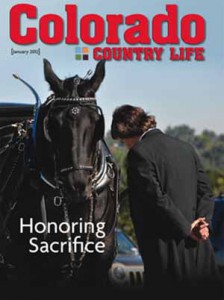
Statewide articles and news fill out the bulk of the magazine, with additional articles and safety tips from the National Rural Electric Cooperative Association office in Virginia.
Members help as well. In some ways the magazine reflects the ongoing conversation between the Colorado Rural Electric Association and the individual co-ops, the national association, related organizations and members.
And that conversation takes all kinds of turns. Neeley says they sometimes hear from readers who’ve lost a recipe they’d saved for years. “I think it ran in the 1980s,” the member might say. Older issues aren’t online or archived electronically, and so when these calls come in it means digging through the archives — usually with success. The two women have been with the magazine long enough (Neeley since 1994 and Wallin since 1997) that they have a good idea of when stories, letters and even recipes ran.
They enjoy and run many of the letters they receive — although the magazine doesn’t have nearly enough pages to print everything, especially on some hot-button issues. Many read like comfortable notes between friends.
“I wanted to share…” begins a handwritten letter on peachcolored paper from Loreta Drenel in Nathrop, who moved there from Kansas and wanted to learn more about her new home. “The articles were a joy and full of information to help me become a Coloradan!” she writes.
The May 2004 issue especially pleased Drenel. It featured a four-wheel drive “rock crawling” on Mount Princeton, just across the Arkansas River behind her home. She knew she had to find Chinaman Gulch and Carnage Canyon, mentioned in the article. “I don’t drive my Jeep on it. Ha! No! No!” she writes, adding, “I also enjoy the electric co-op information, great recipes and the jokes. I think I’ll include some jokes in another envelope! Thanks again for Colorado Country Life.”
“Keep up the good work!” emails Cindy Woods. “The magazine reminds us why we live here.”
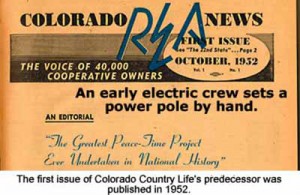 Reader Vicki Swanson bought property west of Pueblo when she returned to Colorado from Alaska. She emails the magazine that “the closest electrical source was $100,000 away over hill and dale.” In 2004, a neighboring rancher subdivided his property. That brought Swanson electricity from Sangre de Cristo Electric Association and Colorado Country Life with it.
Reader Vicki Swanson bought property west of Pueblo when she returned to Colorado from Alaska. She emails the magazine that “the closest electrical source was $100,000 away over hill and dale.” In 2004, a neighboring rancher subdivided his property. That brought Swanson electricity from Sangre de Cristo Electric Association and Colorado Country Life with it.
“I’ve never been more proud of being an American and born in Colorado than I was after reading the article ‘Honoring Sacrifice With a Dignified Farewell’ regarding Lorraine Melgosa, the Wellington Carriage Co. and her funeral horse,” writes Swanson.
Melgosa supplied a horse-drawn hearse for veterans’ funerals at no charge, and the story inspired an avalanche of letters of appreciation for the article and for Melgosa.
Another reader, Kay Cooke, also began receiving the magazine when she moved to Colorado. “It’s a homey-feeling magazine,” she says, speaking to her lifelong love of gardening, canning and farm life.
Rose Woods emailed to say her family appreciates the magazine in part because the Mountain View Electric Association’s scholarships announcement led to their daughter receiving one. The young woman has gone on to receive a doctorate in physics.
“Loved the Ladies of the Brown,” wrote Cindy Gustafson of Pagosa Springs who enjoys the magazine’s book reviews.
The magazine receives dozens of books every year from publishers hoping Neeley will run a review of their authors. Many do end up in the magazine’s pages, especially in the annual Colorado book review issue. Reviewed or not, the books don’t pile up in the magazine’s offices. They go to schools, public libraries, and even once to the USS Mesa Verde. Recipients are chosen by lottery except when there’s a disaster. When a heavily armed man with a grudge and an armored bulldozer barreled through the Granby library in 2004, for instance, there was no question about where the books would go that year. The magazine bolsters community in other ways as well. “People like to see good news about their family in print,” says Nancy Berges, member services director for Highline Electric Association in Holyoke.
Berges, who celebrated 48 years working for the northeast Colorado co-op this August, also describes the magazine as a resource for safety, for information on equipment and techniques, for saving money and for rural advocacy. “One of the best things the magazine does is discuss issues at the state legislature and in Congress.”
At Highline Electric Association, Berges feels as though she’s at the center of the continuing changes that electricity has brought. “The technology is what blows my mind; it’s unbelievable,” she says. “Think about how irrigation works now, how they can monitor exactly how many inches of water they put on. All geared by electricity.”
Earliest days Although Highline was one of Colorado’s first co-ops, incorporated in 1938, Berges says many area residents still talk about “when the lights came on.”
Merle Koch remembers. Up by their windmill, the highest place around, he and his family passed around watermelon slices and then watched their farm world light up. “We thought, ‘Oh, that’s living,’” Koch says.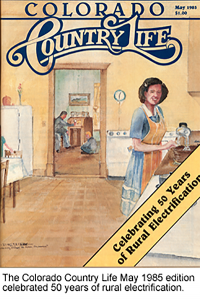
He explains that electricity revolutionized farmers’ lives, made them self-sufficient with air compressors and other tools, no longer relying on neighbors when something needed to be done. “I was a kid when the dust storms came in the ’30s; I wonder why my folks ever stayed,” Koch says. “Then, in the latter ’30s and ’40s, came the rains and electricity. There’s a lot to be thankful for, looking back.”
Colorado’s earliest electric cooperatives, founded in 1936 and 1937, were without a publication for more than a dozen years before the Colorado Rural Electric Association introduced its monthly publication — a newspaper tabloid called Colorado REA News.
It rode the same wave of good fortune as its readers, promoting better living that promised to just keep getting better, year after year. Early issues provide a fascinating snapshot of the time, with articles and editorials on electrical legislation, farm safety, irrigation, recipes and appliances. Every issue celebrated the still-new miracle of electricity.
The magazine helped members use new tools safely, and, especially in those early days, it shared a sense of awe over what rural families could now accomplish. In the second issue, in November 1952, Lewis E. Amend, CREA’s president, penned an editorial titled, “Freedom from Drudgery Our Greatest Blessing.”
“The average kilowatt-hour consumption in this state runs around 2,960 per year,” he wrote, “which means that each of you control on average 3,968 horsepower-hours, and for every horsepower [-hour], you have the equivalent of eight [man-hours] at your command. Each of you, the Lord and Master of 31,944 man-hours serving you and your needs throughout the year. Whether they light the lamps, pump and carry the water, turn the grinding wheels, cool your house or cook your food, they are there and they will work at the touch of your finger.”
An “appliance salesman” Critics had called President Franklin Roosevelt “an appliance salesman” because of his initiative to launch the electrical co-ops. Early issues of Colorado Rural Electric News also celebrated new-fangled appliances. Mrs. Wayne Schiffner of Burlington won $50 in the “My Favorite Appliance” contest with her description of why her favorite was her washing machine.
For anyone who doesn’t think this passes the “so what?” test, try imagining what Mrs. Schiffner’s life was like before electricity and her washing machine. “My machine is ten years old,” she wrote. “We have a family of eight, and during this time a good estimate of laundry washed in this machine totals 106,100 pieces; or: • 8,620 pieces of bedding • 14,586 pieces of household furnishings • 45,454 pieces of clothing • 37,44 diapers.
“Fingers truly worked to the bone, and aching muscles would prevail if I had to do all this with the old-fashioned TUB AND WASHBOARD!”
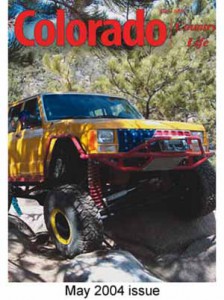 Mrs. Peg Reynolds, coordinator for the Colorado Farm Power Council, served as a contest judge. She argued, “Asking for a favorite appliance is like asking a mother which is her favorite child.” Even so, Reynolds chose her electric dishwasher.
Mrs. Peg Reynolds, coordinator for the Colorado Farm Power Council, served as a contest judge. She argued, “Asking for a favorite appliance is like asking a mother which is her favorite child.” Even so, Reynolds chose her electric dishwasher.
Co-op conspiracies These were years when co-ops — farmers’ co-ops, electrical co-ops, all kinds of co-ops — were relentlessly attacked by the private utilities and their allies as being a socialist plot against free enterprise. The farmers and ranchers didn’t see it that way. In 1952, at the time of Colorado REA News’ first issue, nearly everyone could remember when there was no electricity in most of Colorado. Rural Coloradans lived far differently than their Denver cousins. Nights were truly dark, kerosene lanterns lit the kitchen tables where youngsters did their homework, farmers used a variety of dangerous and unreliable jerry-rigged systems. Car engines and other generators were used for small jobs needing electricity, and woodstoves and fireplaces warmed farmhouses — but not enough to keep ice off the inside of a windowpane.
The lack of electricity in rural America was a drag on the economy. Less than 11 percent of U.S. farms had electricity in the early 1930s, compared to 90 percent of farms in France and Germany. Still, private electric utilities said they couldn’t make a profit stringing miles of line in rural areas. Where they did go, they often charged rural customers four times what they charged urban customers, reflecting the difference in their costs.
On May 11, 1935, President Franklin D. Roosevelt took the controversial step of creating the Rural Electrification Administration through an executive order. A year later Congress passed the Rural Electrification Act and provided funding for loans to help local member-owned electric cooperatives get their start. The cooperatives erected poles, strung lines, built power plants or contacted with existing plants and distributed electricity.
“No longer did the ranchers have to go to bed early,” says Rosemary Knerr, director of communications and member services at Mountain Parks Electric, Inc. “The families changed their lifestyles.”
The privately owned utilities had lobbied hard against the establishment of the co-ops and the accompanying loans that brought electricity to rural areas, and their opposition didn’t let up. Colorado REA News, like a number of its sister publications, began in part to counter the relentless anti-co-op propaganda.
None of the 32 statewide publications, including Colorado Country Life, have gone under. They now reach a total of 12 million readers in 38 states.
Neeley steers clear of gratuitous politics, but she, like the editors before her, takes seriously her charge to keep members informed about developments that could hurt co-ops. Today’s electric associations contend with regulations and rising costs, including the costs of building and maintaining poles and wires. The co-ops all continue to fight to keep electric bills affordable and to keep power reliable and safe. And there is still a difference between the co-op model and that of private utilities.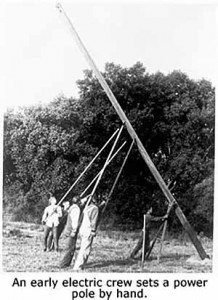
Valdez came to San Isabel Electric from investor-owned Black Hills Power. “There were nice surprises that came with the change,” Valdez says. “At an investor-owned company, the concern is for your shareholders. Sometimes I’d be explaining initiatives there that were good for the shareholders, but not so good for customers. Here, we have members, not customers, and they’re the owners. Everything we do is for them.”
Valdez sees explaining the complexities of how co-ops work as an important part of her mission.
“That’s complicated!” agrees Rod Martinez, a board member since 1987 of Grand Valley Rural Power Lines, Inc. “There are tons of issues I understand now that I didn’t before. I didn’t understand the supply chain, the political issues, the different ramifications of decisions and, more recently, renewables. Our goal as directors is to keep our electricity reliable and affordable, but it’s more complicated than I would have ever thought.” And yet it all comes back to members and their families.
Knerr puts together the four Mountain Parks pages for that north central co-op. “I meet people on the street who tell me they love it when I write stories about members,” she says.
A favorite was about a couple of children with hearing disabilities whose family moved to Granby. The elementary school responded by teaching all its students sign language basics. Kids began signing to each other at home, and when the holiday pageant rolled around, all the kids sang and signed together. “You couldn’t pick out which two were deaf,” Knerr says.
The kids were in it together. That’s a value Knerr, who has worked for the co-op for 30 years, emphasizes. “I’ve seen a lot of changes in the industry and in legislation, but nothing like what’s happening now,” she says. “We’re in this together, so it’s important for members to be aware of the impacts of the changes that are coming.”
Members can depend on Colorado Country Life to cover that news.
Here’s to another 60 years of keepin’ it country.
Kristen Hannum, a Colorado native, is a freelance writer and editor living in Denver. The is her second feature for CCL.

